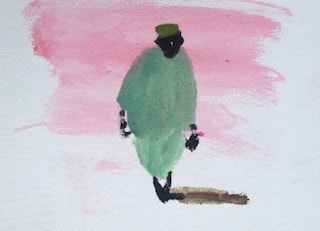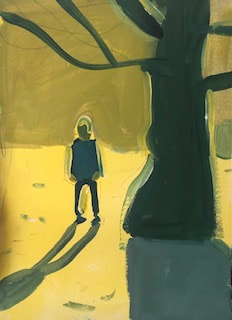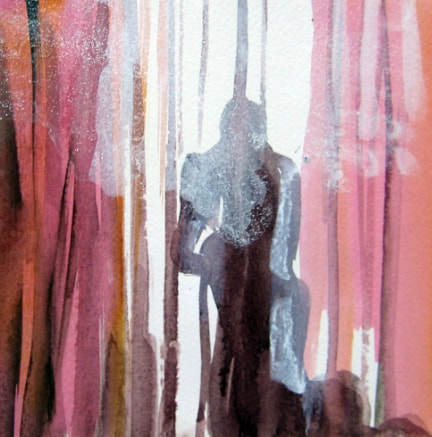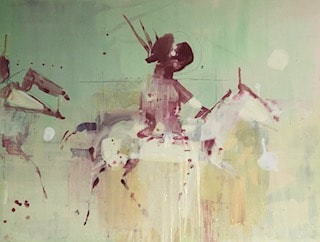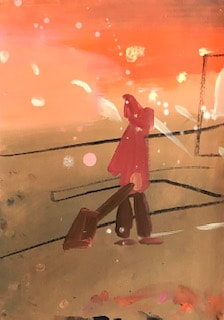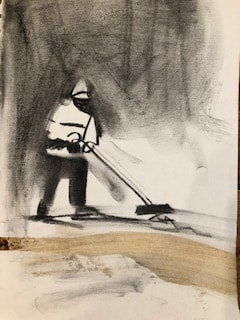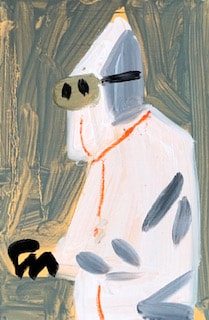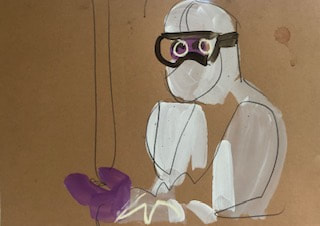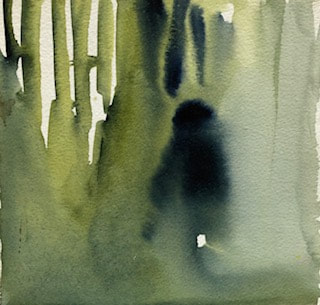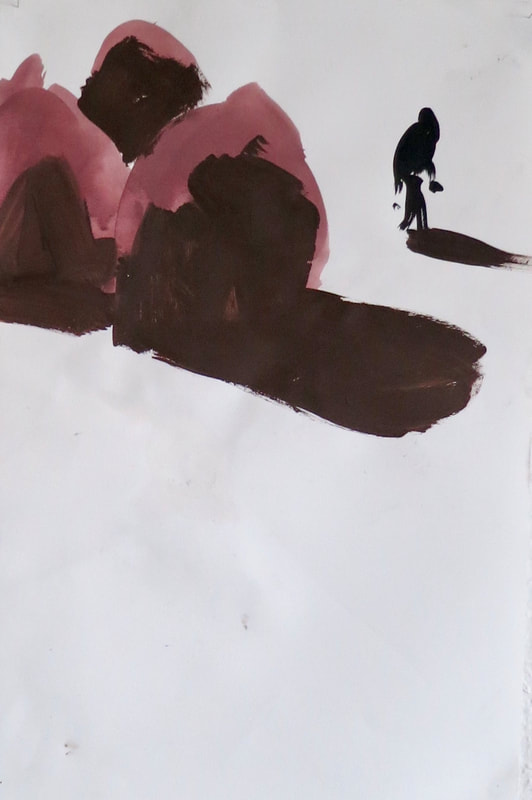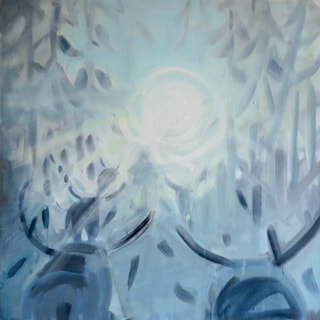Your work sits somewhere between abstraction and figuration. Or perhaps I should say Impressionism with a colder eye, post cultural impressionism if you want. The vision seems affected by the screen, the contemporary screen that probably started out with television and now digital devices. Something beyond. Susan Sontag’s On Photography I suppose.
The hinge between abstraction and figuration is crucial to my work, since I like to abstract or disrupt images, turning them into blots, marks and shapes. This is to keep the image in an unfinished state, to suggest potential that completeness would shut down. It is to pull the recognisable towards uncertainty and to exchange the known for the unknown. For me representational images morphing into abstraction contrast two ways of seeing: seeing things as named objects or as nameless shapes. Such transformations threaten the everyday world of labels with the unnamed and unnameable. I don’t know whether this is impressionist, maybe not, the Sunday fun of certain impressionist works—Renoir’s for example—irritate me, although their quick, lively method of painting may have been influential. From what I remember of Sontag she sees photography as a violation, turning people into objects. I suppose my own drawings and paintings are in a way ‘violations’ of the figure but sometimes with a different intention, an intention not to reduce but to expand possibilities.
The hinge between abstraction and figuration is crucial to my work, since I like to abstract or disrupt images, turning them into blots, marks and shapes. This is to keep the image in an unfinished state, to suggest potential that completeness would shut down. It is to pull the recognisable towards uncertainty and to exchange the known for the unknown. For me representational images morphing into abstraction contrast two ways of seeing: seeing things as named objects or as nameless shapes. Such transformations threaten the everyday world of labels with the unnamed and unnameable. I don’t know whether this is impressionist, maybe not, the Sunday fun of certain impressionist works—Renoir’s for example—irritate me, although their quick, lively method of painting may have been influential. From what I remember of Sontag she sees photography as a violation, turning people into objects. I suppose my own drawings and paintings are in a way ‘violations’ of the figure but sometimes with a different intention, an intention not to reduce but to expand possibilities.
Individuals lose their identity but remain recognisably human and somehow full of character. Paint, crayon, ink and so on are all very equal as well as specific in your work. People and background are treated alike. The application of the marks and smears is clearly spontaneous, well rehearsed but still not mechanical. Although there is your hand or signature in each work, the figures are not simple illustrations or standings for a written text say.
My figures are vulnerable, to nature and life but also to pencil, charcoal, pastel and paint! I like to put figures in bleak or challenging places and then make them more vulnerable by my ‘iconoclastic’ method of drawing and painting which makes and unmakes images. I draw over the figures with lines, obscure them with smears and blots, dissolve them into acrylic fluidity or turn them, as I wrote above, into semi-abstract shapes. In this way they appear damaged, even grotesque, a quality that appeals to me because it faces up to the dishevelled, abject and fragile aspects of humanity.
My figures are vulnerable, to nature and life but also to pencil, charcoal, pastel and paint! I like to put figures in bleak or challenging places and then make them more vulnerable by my ‘iconoclastic’ method of drawing and painting which makes and unmakes images. I draw over the figures with lines, obscure them with smears and blots, dissolve them into acrylic fluidity or turn them, as I wrote above, into semi-abstract shapes. In this way they appear damaged, even grotesque, a quality that appeals to me because it faces up to the dishevelled, abject and fragile aspects of humanity.
The figures are each individuals as well as archetypes. There is a lot of empathy there, Yet they barely hold their individuality just as they perform on the widest stage. Sometimes they seem engulfed by the background, like they dissolve or are dissolved into it.
Yes, I’m interested in metamorphosis and how people are subject to change. I like to paint light and the way in which it can dissolve boundaries and threaten the identity of a figure. The same applies to swimmers, dissolving in water, or to figures seen at night or in mist or snow. I empathise with my figures, yes, as struggling in a world where they are (exposed) to forces that are more powerful than they are. My aggressive use of materials, as detailed above, is a metaphor of this struggle as the figure is engulfed in marks and paint.
Yes, I’m interested in metamorphosis and how people are subject to change. I like to paint light and the way in which it can dissolve boundaries and threaten the identity of a figure. The same applies to swimmers, dissolving in water, or to figures seen at night or in mist or snow. I empathise with my figures, yes, as struggling in a world where they are (exposed) to forces that are more powerful than they are. My aggressive use of materials, as detailed above, is a metaphor of this struggle as the figure is engulfed in marks and paint.
Do you think more of each work as a landscape or an interior in the traditional sense.
I think of them more as landscapes since I paint people in natural or urban wildernesses—these can be polar explorers in wastes of ice, pensioner shoppers in impersonal superstores, road sweepers coping with the filth of the streets, astronauts hanging in outer space and doctors and nurses in the alarming setting of covid wards. The domestic interior has overtones that are too cosy for me.
I think of them more as landscapes since I paint people in natural or urban wildernesses—these can be polar explorers in wastes of ice, pensioner shoppers in impersonal superstores, road sweepers coping with the filth of the streets, astronauts hanging in outer space and doctors and nurses in the alarming setting of covid wards. The domestic interior has overtones that are too cosy for me.
What do you find most inspiring, photography, graphic works, painters. Which works or kind of exhibit typically makes you want to go to your studio and get working.
I am inspired by all those mediums. I look at Japanese prints for their paradoxical treatment of space in which things both recede and come forward and I love Hindu scroll-painting for the use of sour-sweet colours. Cy Twombly and Bacon and Romantic painters like Delacroix are favourites because of the tension in their work between order and chaos. I’m influenced by painters like Larry Rivers who choose to leave unfinished areas and therefore leave space for the indeterminate, for possibility. I also like taking photos from films and using a photographic image which is blurred and distorted.
I am inspired by all those mediums. I look at Japanese prints for their paradoxical treatment of space in which things both recede and come forward and I love Hindu scroll-painting for the use of sour-sweet colours. Cy Twombly and Bacon and Romantic painters like Delacroix are favourites because of the tension in their work between order and chaos. I’m influenced by painters like Larry Rivers who choose to leave unfinished areas and therefore leave space for the indeterminate, for possibility. I also like taking photos from films and using a photographic image which is blurred and distorted.
For some reason I think of a strange mix of dystopian movies, like Metropolis or Blade Runner, and a much lighter tradition, especially in Britain, like Beryl Cook or Lowry, Hogarth perhaps. The mores of people today in social or other situations.
Yes I like dystopian movies I recently saw a good one called ‘Tangerine’ and I choose to place my figures in places of urban dereliction, starkness or alienation. This is true of my drawings based on TS Eliot's ‘The Waste Land’, my supermarket shoppers, my socially awkward figures seated at lavish banquets and recent drawings made in early morning Mile End. The satirical paintings of Hogarth and the downbeat figures of Lowry are great. I love them. But Beryl Cook is too twee and bouncy for me. My work depicts grotesque and damaged figures often in metropolitan settings although the social reality they inhabit is frequently expanded in a surreal way as in the films you mention. I like the idea of the collision of two worlds, a threatening and unfamiliar reality encroaching on the one we know.
Yes I like dystopian movies I recently saw a good one called ‘Tangerine’ and I choose to place my figures in places of urban dereliction, starkness or alienation. This is true of my drawings based on TS Eliot's ‘The Waste Land’, my supermarket shoppers, my socially awkward figures seated at lavish banquets and recent drawings made in early morning Mile End. The satirical paintings of Hogarth and the downbeat figures of Lowry are great. I love them. But Beryl Cook is too twee and bouncy for me. My work depicts grotesque and damaged figures often in metropolitan settings although the social reality they inhabit is frequently expanded in a surreal way as in the films you mention. I like the idea of the collision of two worlds, a threatening and unfamiliar reality encroaching on the one we know.
I’m wondering what kind of fiction might keep drawing you in. How might it relate to your work, the feeling within it.
Good question since I studied literature at Birkbeck between my years at art school. The plays of Shakespeare are influential because of what I said above—the way in which another, supernatural reality intrudes on our own. My Ph. D was on the metamorphosis of identity in Shakespeare’s work and I’ve been interested in this topic as an artist and been inspired by poems and plays in which transformation is a key element: ‘The Tempest’, ‘The Waste Land’, the poetry of Andrew Marvell, the ‘Metamorphoses’ of Ovid. Then lyric poetry, in which an ‘I’ voice speaks, has influenced my depiction of single, isolated figures. Poetry or novels in which the I is a wanderer, travelling through deserts, cities, forests as well as mythical or theological dimensions of hell and purgatory have all fed my work. Lastly, I was invited last year to make drawings on the film set of the Grimm Brothers’ story, ‘Rumpelstiltskin’. These drawings led to a larger series of ‘magical’ landscapes, paintings and works on paper set in forests and woods and based on myth, poetry and fairytale.
Good question since I studied literature at Birkbeck between my years at art school. The plays of Shakespeare are influential because of what I said above—the way in which another, supernatural reality intrudes on our own. My Ph. D was on the metamorphosis of identity in Shakespeare’s work and I’ve been interested in this topic as an artist and been inspired by poems and plays in which transformation is a key element: ‘The Tempest’, ‘The Waste Land’, the poetry of Andrew Marvell, the ‘Metamorphoses’ of Ovid. Then lyric poetry, in which an ‘I’ voice speaks, has influenced my depiction of single, isolated figures. Poetry or novels in which the I is a wanderer, travelling through deserts, cities, forests as well as mythical or theological dimensions of hell and purgatory have all fed my work. Lastly, I was invited last year to make drawings on the film set of the Grimm Brothers’ story, ‘Rumpelstiltskin’. These drawings led to a larger series of ‘magical’ landscapes, paintings and works on paper set in forests and woods and based on myth, poetry and fairytale.
A perennial question, do you have any kind of under drawing, or do you start from a simple colour wash? What is your rejects pile like? Do you ever rework a piece?
I put a coloured ground on the paper or canvas and then draw roughly on this and build up layers. Because I work quickly I have a big pile of rejects but, yes, I return to work that I’ve discarded and maybe rework it, seeing it in a different light after I’ve ignored it for a while.
I put a coloured ground on the paper or canvas and then draw roughly on this and build up layers. Because I work quickly I have a big pile of rejects but, yes, I return to work that I’ve discarded and maybe rework it, seeing it in a different light after I’ve ignored it for a while.
What happens to your working method when you decide to make a ‘proper painting’ on canvas versus your drawings on paper or card.
Another good question as it can be a problem, psychologically, when I think of doing ‘a proper painting’. Generally I favour a mood of nonchalance and calm when approaching it, the same kind of relaxed attitude that I bring to the drawings—which I can easily throw away if things don’t work or are overworked. I tend to have several paintings on the go at once so I can reconsider a ‘problem painting’ a day or so later.
Another good question as it can be a problem, psychologically, when I think of doing ‘a proper painting’. Generally I favour a mood of nonchalance and calm when approaching it, the same kind of relaxed attitude that I bring to the drawings—which I can easily throw away if things don’t work or are overworked. I tend to have several paintings on the go at once so I can reconsider a ‘problem painting’ a day or so later.
To what extent is there a feeling of status of being the helpless observer. What do you make of your life experiences, what you have been as witness and/or protagonist, throughout your life. How do you see your artistic progression from your youth to now.
I think my work oscillates between celebrating energy and will and then sympathising with the opposites of helplessness and indignity, including the indignity of being reduced to blots or specks of paint. I suppose the two are true of life, my life, which, as for most of us, is ‘a mingled yarn’ Shakespeare again of different or opposite experiences. Part of my artistic progression has been to recover and try to express feelings that I felt early on and sensations that I was aware of as a child. I remember, for example, the sensation of mystery and threat around images that were unclear or abstracted, shapes seen on waking or at dusk. My other progression concerns the fact that I gave up painting after 4 discouraging years at St Martin’s in the 1970s—a negative experience caused by sexist, dissolute or aridly conceptualist tutors—and I thought I’d never take it up again. It was simply because of my husband’s emphatic belief in my artistic abilities that I became an artist.
I think my work oscillates between celebrating energy and will and then sympathising with the opposites of helplessness and indignity, including the indignity of being reduced to blots or specks of paint. I suppose the two are true of life, my life, which, as for most of us, is ‘a mingled yarn’ Shakespeare again of different or opposite experiences. Part of my artistic progression has been to recover and try to express feelings that I felt early on and sensations that I was aware of as a child. I remember, for example, the sensation of mystery and threat around images that were unclear or abstracted, shapes seen on waking or at dusk. My other progression concerns the fact that I gave up painting after 4 discouraging years at St Martin’s in the 1970s—a negative experience caused by sexist, dissolute or aridly conceptualist tutors—and I thought I’d never take it up again. It was simply because of my husband’s emphatic belief in my artistic abilities that I became an artist.
These seem works born in a very urban experience. The city as a stage set. If anything there’s a suggestion of works by Degas via Tuymans in engaging with photography, composition and image. But also in the thoughtful engagement being brought to the observed experience.
I love the way in which Degas and Tuymans crop images to make them surprising, abstracted and awkward and yes, as I said above, urban subject matter is important to me. I like to paint mess, and city mess is inspiring as are the flashes and flares of neon in a city at night. However the city is only one kind of ‘wilderness’ that I paint. I also like doing figures in other and more challenging settings, places of extremes like the Arctic or the Moroccan desert or an icy forest.
I love the way in which Degas and Tuymans crop images to make them surprising, abstracted and awkward and yes, as I said above, urban subject matter is important to me. I like to paint mess, and city mess is inspiring as are the flashes and flares of neon in a city at night. However the city is only one kind of ‘wilderness’ that I paint. I also like doing figures in other and more challenging settings, places of extremes like the Arctic or the Moroccan desert or an icy forest.
